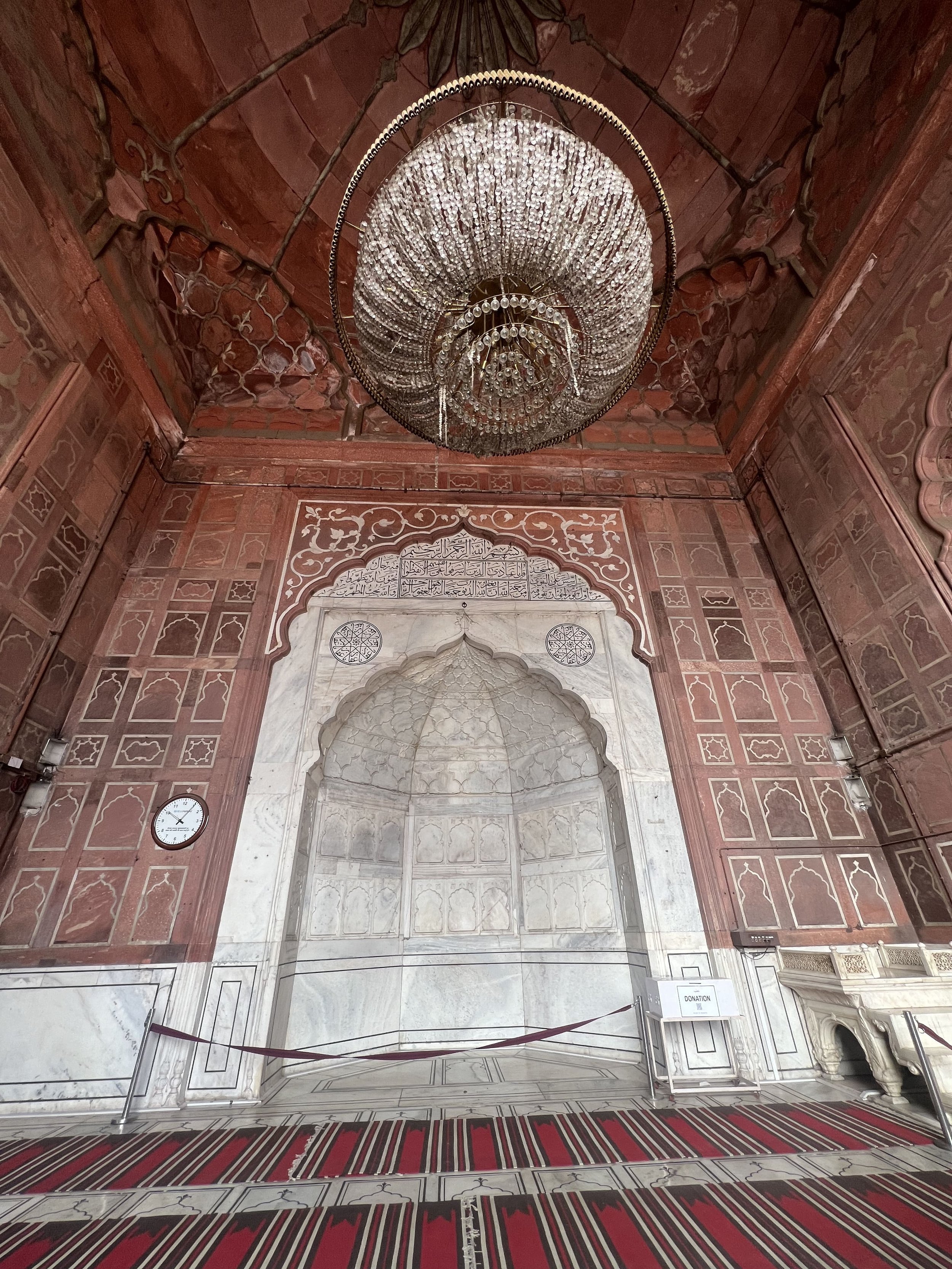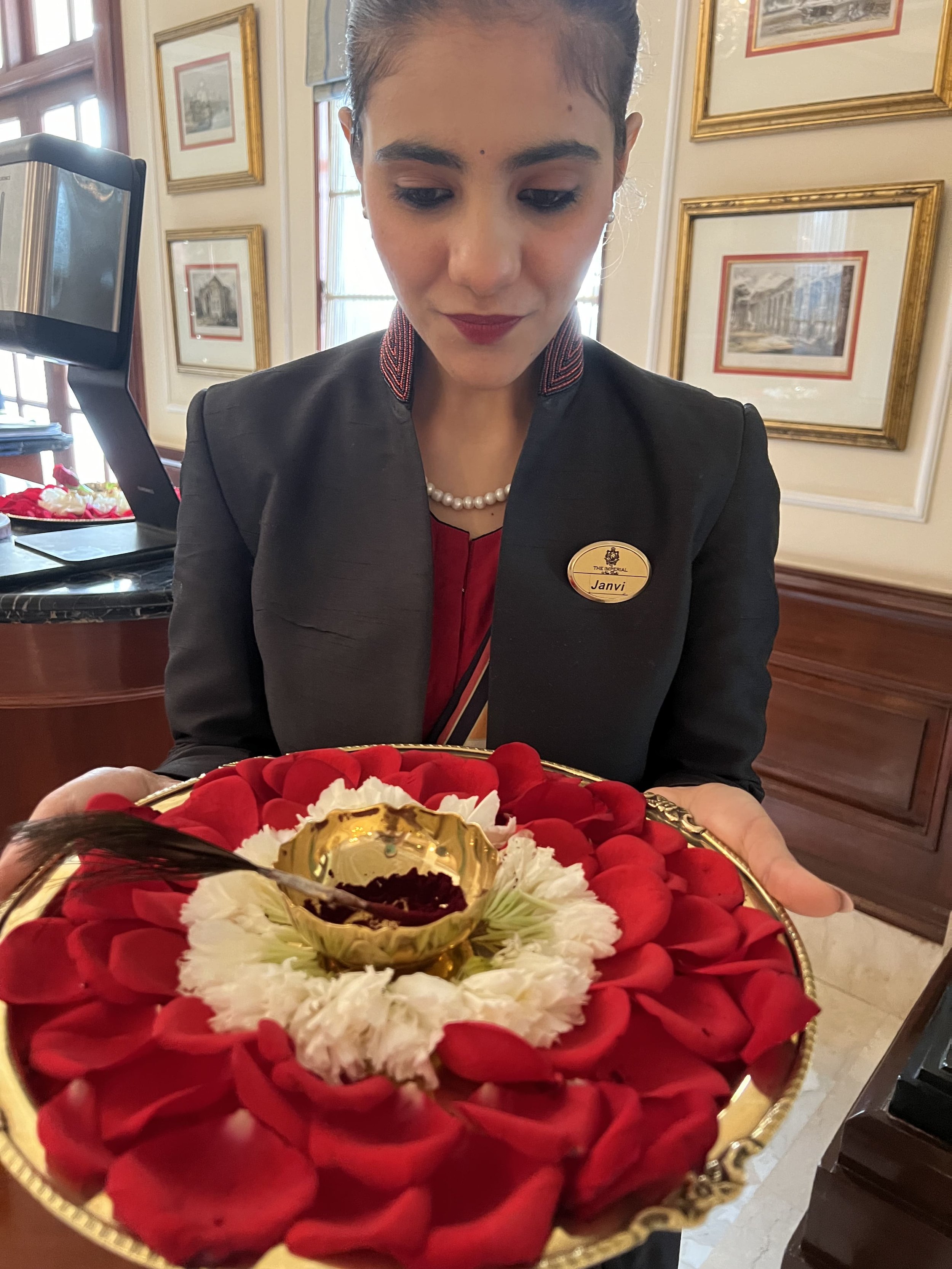Delhi
India's mega metropolisDelhi was our last destination in India, after Mumbai, Rajasthan, Agra and Varanasi. By then we felt quite knowledgeable about its customs. But Delhi would also surprise us.
We arrived on a domestic flight from Varanasi at six in the evening. We were met by Shiva, our driver. When we got into our car, we were surprised both by the cross hanging from the rear-view mirror and the stickers with little Argentinean flags. When we asked him, he told us that he was a Catholic and that the little flags had been given to him as a present by a passenger he had driven for some time before.
In India there are many religions, the majority being Hinduism, followed by Islam. But there was Shiva, our Catholic driver, to continue surprising us. The Catholic community, he explained, is concentrated in Calcutta and Delhi.
We drove along the modern highways, crowded with cars, but by then it didn't feel as chaotic as we had read, especially compared to others we had previously visited, such as Agra, Jaipur or Mumbai, to name but a few.
The pollution was indeed shocking, surpassing Varanasi by a third. It was a clear day but the mobile phone was once again on alert for pollution, just as it had been on previous days. Arriving at The Ashtan Sarovar Portico hotel, another extraordinary event took place. One of those that happen in India. India.
It turned out that in Jaisalmer, following a tip from our agent Helena, we had bought the fabulous pashminas of genuine cashmere from the beautiful shop of Riyaz, a native of the mountainous area of Kashmir, home to the particular goats whose wool is so prized for its fine texture and warmth.
A few days after that beautiful bubblegum pink pashmina (as Riyaz called it) purchase, I felt a sense of regret for not having bought another one in a natural, off-white colour. I contacted Riyaz via whatsapp and he immediately found the solution. He told me that he would send it to Delhi and a friend of his would bring it to my hotel. And so it was. As soon as we checked in, the concierge told us that Riyaz's envoy was waiting for us in the lobby. I handed him the agreed rupees and he handed me the beautiful nude-coloured pashmina, a marvel!
In the research that precedes @tripticity_ trips, we had found a wide range of gourmet options to enjoy in Delhi, a mega metropolis known for its fine cuisine. That night, after negotiating with our agency for an unplanned transfer to the nearby Leela Palace Hotel, we arrived at Jamavar, its Indian specialty restaurant.
It was an extraordinary feast, pure luxury with outstanding service from the staff.
We accompanied the marinated tandoori chicken and spiced lamb kebab with an Indian sangiovese wine from the Fratelli winery; of course, with garlic naan and parantha, the soft and the crusty, the two versions of Indian bread that were our favourites.
The desserts were out of this world. We tried the gulab jamun, which we had already tasted in Jaisalmer, a spiced milk-filled dumpling with rose water, a huge pistachio-based sweet, and cheese balls with saffron.
The next day was a marathon tour of the city.
We started in the old quarter. First, we visited the Jama Masjid, the largest mosque in India. Once barefoot, we rented some colourful robes to get inside. By the way, there is no way to enter without these robes. From inside you get a very good view of the Red Fort.
Helena had told us that it was not advisable to visit the interior, since in Rajasthan the forts were more interesting, so we continued with the fun experience she suggested of taking a ride in the typical cyclorickshaws, the carts guided by a man on a bicycle, through the vibrant district of Chandni Chowck, in Old Delhi.
We and the guide got on, so I found it a bit distressing to see how hard poor Mustafa was struggling. We stopped at the spices section. There, everything caught our attention: the man exchanging coins, the construction workers waiting to be hired, squatting with their tools on one side, the men carrying giant bags back and forth, the cows wandering in the alleys, the colourful flowers of the stall holders, the strong aromas of the spices, everything.
Then a short drive to Rajghat, the great memorial of Mahatma Gandhi. We continue on to the Sikh temple, Gurudwara Bangla Shabib. What is impressive here is not so much the architecture but what goes on inside the walls. The Sikhs feed thousands of worshippers, of whatever religion and belief, every day, so entering the huge kitchen where volunteers prepare the stews is moving and even a little disturbing. Outside, a large pond precedes the temple, whose water is considered miraculous.
We made a much-needed stop at Connaught Place, for a coffee at the western Starbucks to refuel. Mr @tripticity_ had broken down upon entering a public toilet, perhaps a sign of saturation from the experiences India exposes you to, those that push you beyond the known limits of tolerance in terms of filth, rubbish and exposure to unpleasant situations.
The coffee had its miraculous effect so we continued on to Birla House, Mahatma Gandhi's residence in the city and the site of his assassination, after a quick stop at the iconic India Gate.
A very unique visit continued to the Bahai's Temple or Lotus Temple, a modern white marble building, composed of huge leaves symbolising the flower. The queue of people to enter was very long. But our guide led us in such a way that we slipped through the entrance with impunity. Indian rules? We don't know, but between our Argentinean DNA and the tiredness we were beginning to feel, it didn't even cross our minds to ask. In the huge complex, surrounded by green and flowery gardens, thousands of people wandered from one side to the other, taking selfies. The Bahá'i religion espouses the common values of all religions and the union of peoples, so believers of all faiths are welcome there.
By the time evening was setting in, we visited the monumental complex of the Qutub Minar Victory Tower, a World Heritage Site. The tallest brick minaret in the world and an outstanding example of Islamic art, with a height of over seventy metres.
Exhausted, we gave up for the night after the marathon itinerary.
The next day, we had planned a day of rest and luxury at the iconic The Imperial. It was our last day in India and we wanted to recharge our batteries for Nepal, the next destination.
And so, at the historic lodge, we enjoyed the radiant day of sunshine and somewhat celestial skies (unusual for Delhi) while swimming in the huge pool. Then I took a yoga class at their fabulous spa and we bid farewell to India with dinner at their famous restaurant The Spicy Route.
The décor of the place is extraordinary, a combination of Asian architecture, like their menu, a fusion of flavours from the great continent.
We ate well but it was nothing extraordinary, especially because of the frenetic attention of the waiters who seemed anxious to remove each dish, almost not allowing us to enjoy our meal in peace and quiet. The gastronomic quality was already impeccable from a technical point of view, but we felt that the chosen dishes lacked soul. Therefore, we decided to get up and visit the beautiful Patiala Peg bar for dessert. There we enjoyed some phenomenal drinks while toasting our journey through the subcontinent, being thankful that we stayed healthy for all those days and were able to intensely enjoy all that India has to offer. For those who dare to experience it, it will be one of the best experiences of a lifetime.
The next day, after an outstanding breakfast in the beautiful art deco restaurant 1911, named after the year Delhi became the capital of British India, we left for the giant Indira Gandhi International Airport to catch our flight to Kathmandu, happy and grateful.






















































































































